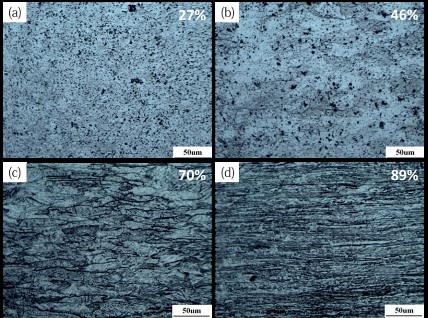
由于钨的加工性差,轧制过程必须在高温下进行。烧结态的板坯厚为36.5 mm厚,在开坯轧制前将烧结坯在氢气气氛中加热到1450℃(1723 K)以上,随后进行单向轧制,在轧板厚度为26.6 mm、 19.7 mm、10.9 mm和3.6 mm时分别进行取样,对应轧制形变量分别为27%、46%、70%、90%。每个轧制道次之间进行低温退火处理,退火温度低于1100℃(低于钨的再结晶温度)以缓解应力集中而避免产生裂纹。使用配备电子背散射衍射(EBSD、AZtec系统、牛津仪器)的场发射枪扫描电子显微镜(FE-SEM、JIB 4600F)对微观结构进行表征。对于每个轧制压下板,在TD视图(垂直于横向的平面)中进行观察。对EBSD样品进行机械抛光,然后在环境温度下用2.0 wt%NaOH水溶液在5.0 V下进行电解抛光。然后通过HKL Channel 5软件进行晶粒尺寸、织构分析。
Due to the poor workability of tungsten, the rolling process must be carried out at a high temperature. The thickness of the sintered slab is 36.5 mm thick. The sintered billet is heated to above 1450°C (1723 K) in a hydrogen atmosphere before billeting and rolling, and then subjected to unidirectional rolling. The thickness of the rolled plate is 26.6 mm and 19.7 mm. Samples were taken at mm, 10.9 mm, and 3.6 mm, and the corresponding rolling deformation variables were 27%, 46%, 70%, and 90%, respectively. Low-temperature annealing is carried out between each rolling pass, and the annealing temperature is lower than 1100°C (lower than the recrystallization temperature of tungsten) to relieve stress concentration and avoid cracks. A field emission gun scanning electron microscope (FE-SEM, JIB 4600F) equipped with electron backscatter diffraction (EBSD, AZtec system, Oxford Instruments) was used to characterize the microstructure. For each rolling reduction plate, observe in the TD view (a plane perpendicular to the transverse direction). The EBSD samples were mechanically polished and then electrolytically polished with 2.0 wt% NaOH aqueous solution at 5.0 V at ambient temperature. Then use HKL Channel 5 software to analyze the grain size and texture.